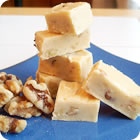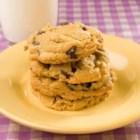
Candy Making Tips
By: Sydny Carter
Visions of Sugarplums
Candy is a year-round treat, but it is especially wonderful during the holidays. Making fudge at Christmas can quickly become a family tradition, with the whole family coming together to make this wonderfully simple confection. Candy can also be a great homemade gift for friends and family. After all, who would not want to receive a box of homemade chocolate truffles in their stocking? Although you can spend a lifetime learning everything there is to know about the confectioners' trade, there are plenty of easy to make recipes that will delight your friends and family. All you need to get started are a few common kitchen items, some simple ingredients, and a modicum of know-how.
Tools of the Trade
Most of the tools needed to make candy can be found in a well-stocked kitchen:
- A medium-sized saucepan with a heavy bottom and straight sides is a must. It should be large enough to hold 3 to 4 times the volume of the ingredients; this will help prevent boil-overs.
- A bowl, large enough to hold the saucepan, allows you to cool the candy while it is still in the pan. The temperature of the sugar mixture continues to rise even after it has been removed from the heat. Immersing the pan in cold water or an ice water bath stops the cooking at just the right time.
- A long-handled wooden spoon.
- A pastry brush reserved exclusively for candy-making. Some recipes will call for brushing down the sides of the pan with water to prevent crystallization.
- A good candy thermometer. Although it is possible to make candy without one, a glass candy thermometer is invaluable to the beginner, and a useful tool for the professional. If possible, buy one equipped with a metal clamp that attaches to the side of the pan.
- If you make candy on a more regular basis, you may want to invest in a marble slab and a copper caramel pan, but these are by no means necessary.
Only the Best
Sugar is the most basic ingredient in candy. Use an unopened package of sugar; this will ensure that there has been no contamination from other ingredients commonly found in the kitchen, such as flour or salt. Use unsalted butter; the salt content of salted butter can affect your final product. Never use margarine in a recipe that calls for butter: margarine has a higher water content, which will significantly affect the cooking time and results.
Hints and Tips
Before you turn on the stove, take the weather into account. On rainy or humid days, the cooking time can increase substantially or your candy may never set up at all. Sugar attracts water, so the humidity can adversely affect your recipe; wait for a clear, dry day.
Test your thermometer to make sure it is accurate. (You will need to do this every time you make candy.) Immerse it in a pan of water, and bring the water to a boil. The temperature should read 212 degrees F (100 degrees C). If it does not, you will need to adjust your recipe to reflect this. For example, if your thermometer reads 215 degrees F (102 degrees C) in boiling water, and the recipe requires that you cook the candy to 250 degrees F (121 degrees C), you will need to cook the mixture to 253 degrees F (123 degrees C).
Last, but not least, measure all your ingredients before you begin. It takes a long time to reach 220 degrees F (104 degrees C), but after that the temperature rises quickly. You will need to have everything within easy reach.
Sugar Cooking
Dissolve sugar into liquid ingredients over low heat, and then bring to a boil. Don't stir once the sugar has dissolved, unless directed to by the recipe. Either clamp the thermometer to the side of the pan, or periodically place it in the syrup to measure the temperature. The bulb of the thermometer should not touch the sides or bottom of the pan, or you'll get an inaccurate reading. Always clean the thermometer after each testing, and keep it by the stove in a glass of warm water. Cook until the desired temperature is reached. Immediately remove the pan from the heat, and cool the bottom of the pan in the bowl of ice water to stop the cooking. (For peanut brittle, pour the hot candy onto a greased baking sheet or oiled marble without cooling.)
If you don't have a candy thermometer, use the cold water method to test the candy. Drop a small amount of the mixture into a glass of cold water, and then examine it closely to determine if it's at thread stage, soft ball stage, hard ball stage, etc. Remove the pan from the heat while testing to avoid overcooking the candy. Use a fresh glass of water for each test.
Cooking On High
As with most cooking at high altitudes, there are modifications that need to be made to candy recipes. For every 500 feet above sea level, decrease the temperature by one degree. If you live at an altitude of 3500 feet and the recipe calls for cooking to 234 degrees F (112 degrees C), cook it to 227 degrees F (108 degrees C).








